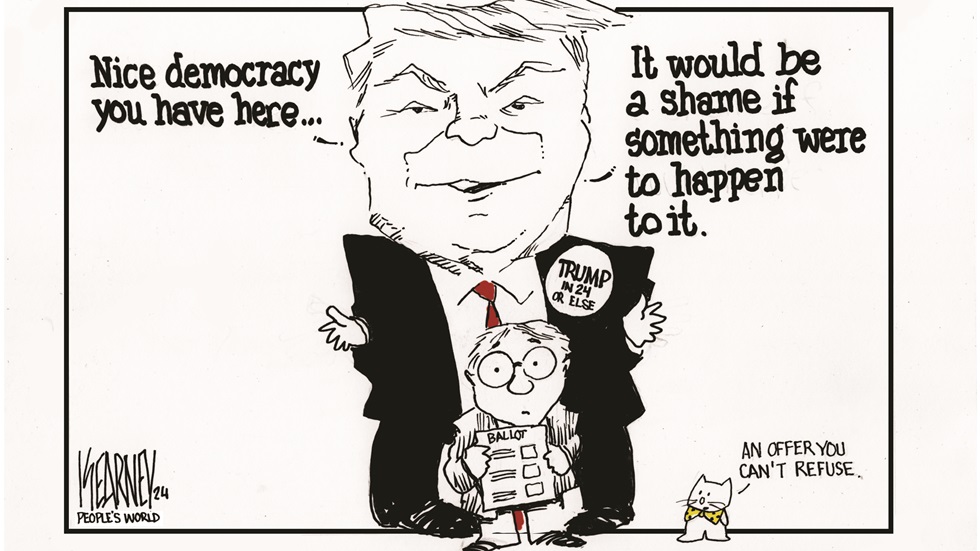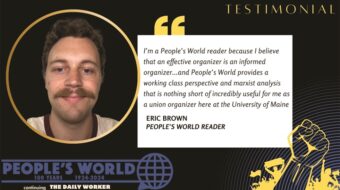
“I was always a political cartoonist,” said Kearney, whose award-winning work appears in People’s World. “I started at the Morning Sentinel in Waterville, Maine. I’m probably the youngest of the cartoonists who remembers drawing Nixon.”
Kearney grew up in a radical FDR New Deal household in New Sharon, Maine, a town of 1,400 people. He still speaks a distinct Maine dialect and spins a good yarn.
Most jobs in one of the poorest parts of the state were farming or dairy-related. Kearney’s father was a psychiatrist for the state, and his mother was the first librarian for the Margaret Chase Smith Library, named after the famed senator, when “you didn’t worry about the safety of the country when you elected a Republican.”
“(My family) were radical, supporters of socialists, FDR, and New Deal, and I grew up in that milieu of labor democratic politics and we were expected to talk about politics at the dinner table.”
Because his mother was a librarian, “there was always stuff lying around like Life Magazine and Readers Digest. One thing we got every week was a copy of Soviet Life. My parents expected us to read it all.”
He attended Brigham Young University (BYU) in Utah because it was the most affordable option and became a cartoonist for the campus newspaper.
“BYU has a whole host of sacred cows that are just there for people to come along and poke. The stable of working cartoonists who came out of there was unusual,” he recalls.
Kearney graduated in 1980 and continued drawing. Several newspapers published his cartoons; one, the Casper Star-Tribune in Wyoming, owned by the wealthy Howard family, offered him a job.
“I was the only cartoon editorialist in the state, and I was known everywhere.” His notoriety led to clashes with elected officials, including then-U.S. Senator Al Simpson.
“Simpson is a traditional Republican. And he and I would spar. He would say something, I would draw about it, and he would write a letter criticizing me,” said Kearney.
“One day he comes barreling into the newsroom and comes up to the editor’s desk and yells, “Where is that little pig f____er, Kearney?” The editor pointed to me and he came over to complain about something I had drawn about.”
“Later, my late wife, who was blind and a lobbyist for the National Federation of the Blind, was in Washington, D.C. She went with a group into Simpson’s office, and they were all introducing themselves. When it got around to my wife, she said, “Hello, Sen. Simpson. I’m the little pig.” It took him a while, but eventually, he got it, and everyone had a big laugh.
“A cartoonist is just like a writer,” said Kearney, describing his creative process. “A writer must write every day. A cartoonist is like that too. You must draw every day. Even if you come up with a bad cartoon, you must do it every day.”
“I’m one of the fastest cartoonists working,” says Kearney. “(Legendary cartoonist) Pat Olifant and I are probably the fastest. I seldom spend more than an hour drawing those cartoons. I usually have a clear vision in my mind and do it in only one take. Sometimes, I think we made it look too easy which drove editors crazy.”
According to Kearney, the news side of the traditional media operation is scared to make waves. “We’ve got to be careful, the editors say. Our quotes must be just what was said. We must keep notes and have both sides of the story.”
“Then the cartoonist comes along, and all those rules get thrown out the window. He gets to make up quotes, put things in people’s mouths that they never said, and make politicians do ridiculous things, like selling “stupid pills” that never happened. Reality doesn’t matter. Facts don’t matter,” laughed Kearney. “The editors ask, why are we letting people who are like court jesters get away with this stuff?”
“Most of my drawings are for small rural newspapers,” in Montana, Nebraska, South Dakota, and the upper Midwest, says Kearney. “The beating heart of these communities is farming. I’m always trying to say to these farmers: you’re being mistreated, don’t vote for these people mistreating you,” he says.
“Some of my editors are very conservative and I think I draw in such a way that they can see what I’m saying is right. Some just want a cartoonist that’s different than what they say in the editorial.”
“Cartoons are the strongest form of editorial, by far,” observed Kearney. “They boil complex issues to their rawest form and can be consumed in 15 seconds. And I think the editorial cartoon can stand alone as a regular opinion piece.”
One thing that attracted Kearney to People’s World was the rich history of editorial cartoonists in The Daily Worker and The Worker, including Ollie Harrington, Art Young, and Bob Minor, whose work often ran on the front page.
“People’s World is out on the left edge. My politics are what used to be called “labor democratic,” and now called democratic socialist, like Bernie Sanders,” he said.
Kearney is dismayed by how industry monopolization and Wall Street hedge funds are decimating editorial cartooning. “When I went into the profession, over 300 editorial cartoonists were working in the United States. That doesn’t sound like a lot. As of today, there are less than 35. I’m one of those holdouts. Most are retiring, but I won’t give them that pleasure.”
“Cartoonists are always the first to get thrown overboard when newspapers get in trouble,” said Kearney, despite their popularity with readers. “Let’s face it: You can spend all day writing some high-toned principled editorial extolling the virtue of universal health care, and nobody’s ever going to clip it out of their newspaper and put it on the refrigerator, are they? But they will do that with cartoons.”
“I know times are tough, but some of this is (the owners’) own doing,” said Kearney. “When I worked for the Howards (at the Casper Tribune), they had a rule that 10% of profits went to the parent company. The newspaper kept the rest and invested in reporting. Now the Newhouse or Gannett chains expect newspapers to pull in 30% profit,” he said incredulously.
“You’re not always going to agree with me and if you strongly disagree with me write a letter to the editor. Tell them you think Greg Kearney is a scoundrel!”
People’s World hopes Greg’s work continues to grace this website poking sacred cows, MAGA extremists, and hypocritical politicians in the tradition of great radical editorial cartoonists.
We hope you appreciated this article. At People’s World, we believe news and information should be free and accessible to all, but we need your help. Our journalism is free of corporate influence and paywalls because we are totally reader-supported. Only you, our readers and supporters, make this possible. If you enjoy reading People’s World and the stories we bring you, please support our work by donating or becoming a monthly sustainer today. Thank you!












Comments